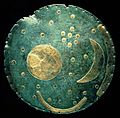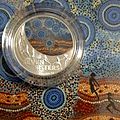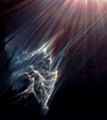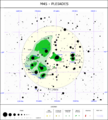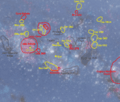Pleiades facts for kids
Quick facts for kids Pleiades |
|
|---|---|
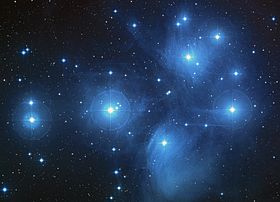
|
|
| Observation data (J2000 epoch) | |
| Constellation | Taurus |
| Right ascension | 03h 47m 24s |
| Declination | +24° 07′ 00″ |
| Distance | 444 ly on average (136.2±1.2 pc) |
| Apparent magnitude (V) | 1.6 |
| Apparent dimensions (V) | 110' (arcmin) |
| Physical characteristics | |
| Other designations | M45, Seven Sisters, Melotte 22 |
The Pleiades (also known as M45 or the Seven Sisters) are a group of stars in the night sky. You can see them in the constellation Taurus, the bull. Charles Messier gave it the name M45. They are named after the Pleiades in Greek mythology.
This an open star cluster of middle-aged hot B-type stars in the constellation of Taurus. It is one of the nearest star clusters to Earth, and is the cluster most obvious to the naked eye in the night sky. The cluster is dominated by hot blue and extremely luminous stars that have formed within the last 100 million years.
Images for kids
-
The Nebra sky disk, dated circa 1600 BC. The cluster of dots in the upper right portion of the disk is believed to be the Pleiades.
-
Hubble Space Telescope image of reflection nebulosity near Merope (IC 349)
-
The approximate location of the Pleiades just above the Local Bubble in the middle of this map of the Orion Arm (yellow: major stellar associations; red: nebulae; grey: dark nebulae.
See also
 In Spanish: Pléyades (astronomía) para niños
In Spanish: Pléyades (astronomía) para niños


